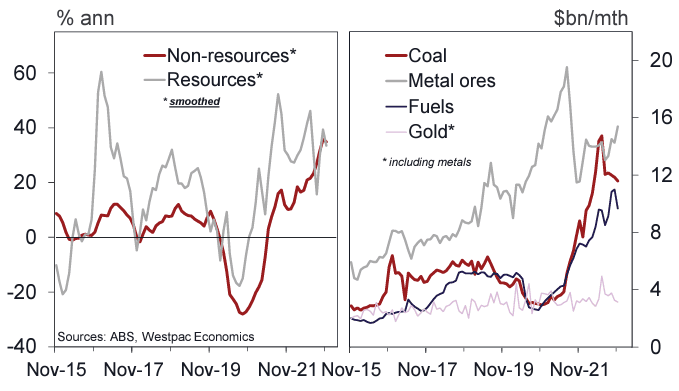Australian Dollar Outlook Buoyed by Another Strong Trade Surplus
- Written by: Gary Howes
-

Above: Australia's trade surplus surprises again. Image courtesy of Westpac.
The Australian Dollar's golden egg - the country's trade surplus - surprised to the upside in November, according to data released on January 12.
Australia's trade surplus widened by $0.5BN to $13.2BN in November from $12.217BN previously, beating expectations for a decline to $10.5BN.
The boost comes despite lower commodity prices that would have lowered the value of Australia's iron ore, coal and natural gas exports.
"One factor driving the surprise was a stronger starting position on an upgrade to the October surplus, to $12.7bn from $12.2BN," says Andrew Hanlan, Senior Economist at Westpac. "A smaller import bill also contributed to the larger surplus. Imports declined by -1.5%, down 0.7%, rather than being flat as we anticipated."
The trade surplus reflects Australia's fundamental ability to earn foreign currency and is therefore a solid source of support for Australian Dollar value.
The data comes amidst a period of outperformance for the currency: the Australian Dollar to U.S. Dollar exchange rate (AUD/USD) is now looking to record a fourth successive weekly advance and is quoted at 0.6893 at the time of writing.
The Pound to Australian Dollar exchange rate (GBP/AUD) has meanwhile fallen for three weeks in succession and is quoted at 1.76 at the time of writing.
The decline in spot takes bank payment rates to approximately 1.7130, competitive holiday and cash rates to around 1.7464 and competitive international payment rates to around 1.7570.
The latest trade data shows the services sector has taken some of the slack posed by falling commodity prices in the second half of 2022: total tourism-related exports (which includes foreign students) rose a further 8.7% in November, adding +$0.3BN to the accounts.
The services account is overall in deficit following the reopening of Australia's borders, but services exports are nevertheless growing and are set for a further boost in 2023 as improved relations between Canberra and Beijing result in a surge in applications for Australian university places over recent weeks.
Chinese students are estimated to be worth about $40BN to the Australian economy and the revived interest in Australia's education sector will be further aided by China's effective abandonment of the zero-Covid policy.
"Tourism, education and property sectors in Australia could benefit if relations between China and Australia start to warm up. This is positive for AUD. Not forgetting China reopening story and Fed policy calibration thematic that can further add to long AUD bias," says Christopher Wong, FX Strategist at OCBC Bank.

Image courtesy of Westpac.
"The relaxation of COVID restrictions in China and subsequent increased economic activity may push up Australian commodity and tourism exports higher in coming months," says strategist Joseph Capurso at Commonwealth Bank of Australia.
Thawing political relations also saw China book its first Australian coal cargos in two years this January, which will further underpin Australia's trade dynamics in 2023.
The Australian Dollar is 2023's best-performing currency on developments in China and much of the good news appears to be 'in the price', which could result in some near-term consolidation.
Fundamentals nevertheless remain firmly in favour of the Australian Dollar outlook at this point, underpinning analyst expectations for upside over the coming months.
"Within the space of commodity FX, we prefer the Australian dollar," says Claudio Wewel, FX Strategist at Bank J. Safra Sarasin. "Given Australia’s exposure to the Chinese economy, its currency should be the primary beneficiary of a lifting of Chinese COVID restrictions."





